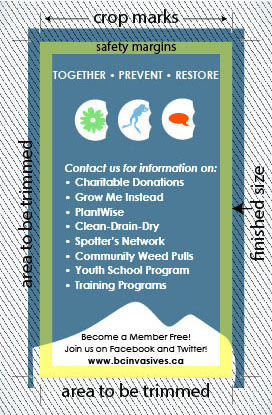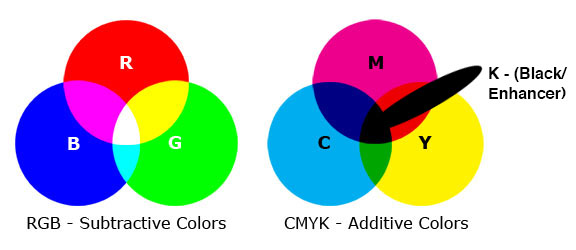File Guidelines
Do you know that the number one cause of poor quality printing is incorrect document file preparation?
Following our file preparation guidelines will save you time and money!
Our production workflow is PDF based. In other words, all print jobs are sent to our Digital and Offset Presses in PDF (Portable Document Format). Print-ready PDFs contain all the necessary information for documents to be accurately previewed on screen and printed. All fonts and images can be encapsulated within the PDF document, enabling it to be transferred to, and printed from other computers without the need to transfer fonts and images. In order for your PDF to properly print, it is best for you to convert your document into PDF format on the computer where the document is created. When you convert your file to PDF, be sure to use the High-Quality print setting, or PDF/A. This will ensure that your Fonts are all embedded in the document, and that all pictures and graphics will transfer in high resolution.
DOCUMENT DIMENSIONS
Make sure your files are all created and exported to us sized to the actual dimensions you want them printed. The industry standard unit of measurement is imperial inches. In the case where your document dimensions are small enough to be printed multiple times on a press sheet, such as a business card, please provide your file 1-up. We automatically calculate and "inposition" your supplied art file multiple-up for maximum efficiency. So there is no requirement for you to "step and repeat".
RESOLUTION:

When creating a document to be printed, use only high resolution (300 dpi or more) images. Most images copied from the internet are only 72 dpi and suitable only for viewing on a monitor, but not for printing.
DOES YOUR DOCUMENT HAVE BLEEDS?

The term "Bleed" refers to any printed image that extends to the edge of the paper. Digital and Offset presses can not print right to the edge of a sheet, and therefore documents with bleeds must be printed on on oversize sheet (press sheet), and then cut down to the finished size. When preparing a document with bleeds, add .125" bleed on all sides. This means that any pictures or design elements that go to the trimmed edge of the paper, must extend beyond the edge by .125" in your document file. Also, crop (trim) marks are required to indicate the finished cut. Our cutter operator will use the trim marks as a guide when cutting the printed piece to its final size. Most professional design applications such as Adobe Indesign have features to help you include proper bleeds and crop marks.
SAFETY MARGIN
Regardless whether your document has bleeds or not, all critical elements in your document must be kept away from the cut line (or final size) of the finished document. Because paper is a porous, organic material, sensitive to temperature and humidity, it may distort slightly during print production. Although our controlled production environment keeps these factors to a minimum, final cutting requires a safety margin of variance for cutting. For this reason, we do not recommend tight fitting borders. However, if a border is crucial to your design, they should be at least 1/8" from the cut line. Additionally, a margin of space between text and design elements is a good design principle to follow, resulting in a better looking piece that is easy to read.
COLOURS

Full colour digital and offset presses print in process colour (CMYK = Cyan, Magenta, Yellow, Black). In contrast, all computer monitors display colour in RGB (Red, Green, Blue). We recommend that you convert your colour images to CMYK before sending the file to us. This will give you a better idea how they will look once printed. Keep in mind that how your document looks on screen is still not an accurate representation of how the finished piece will look. If colour accuracy is critical, we recommend that you request a pre-press proof for viewing before we proceed with your order. For black and white print jobs, use grayscale mode (not CMYK or RGB). For one or two colour print orders, use Pantone spot colours. The Pantone Match System (PMS) is an industry standard system of matching colour using a colour formula book. If you do not have a PMS swatch book, we have one on hand for viewing.
TRANSPARENCY
Any designs that include the features of transparency such as drop shadows and glows are not compatible with spot colours, and therefore must be produced in CMYK. In this case, convert all spot colours in your document to CMYK, and then flatten all transparencies before sending us your file.
BOOK BINDING
We offer a variety of bookbinding styles and methods. A common and economical option is Saddle-stitch binding, with flats folded and seated together with wire staples in the spine of the book. Each sheet of paper in a saddle stitch book will make 4 numbered pages. If the document page count does not equal a multiple of 4, the last page(s) can be left blank or used for notes or comments by the reader. To avoid any confusion regarding "readers spreads" and "printer spreads", we recommend that you supply us your booklet in single page format (1 page up), with all your pages combined into one pdf file. Our prepress software will automatically impose your document into printers spreads for us to print. You may paginate (add page numbers) to your document, or if you prefer, we can do the pagination for you.
We also offer Cerlox, Spiral and Perfect binding. Cerlox binding is suitable for smaller quantities (100 or less) and can be opened for pages to be added later. Spiral binding is more durable than Cerlox, and is ideal for cookbooks, pocketbooks and manuals, because it allows the book to lay flat when open. Both Cerlox and Spiral bindings require a margin of 1/4". However, for readability and aesthetics we recommend 3/4 to 1 inch margins. Perfect binding is suitable for books produced in larger print runs, due to a higher set up cost.
COMMON PAPER SIZES
The North American industry standard unit of measurement for paper sizes is imperial inches. Some common finished paper sizes are:
Business Card 2 x 3.5"
Letter 8.5 x 11": Due to its commonality, Letter size paper is an economical choice for many documents.
Legal 8.5 x 14": Intended as a specialty size for Legal forms, 8.5 x 14" size is not an economical size for most printing projects. If cost is a factor, avoid legal size wherever possible.
Ledger and Tabloid 11 x 17": Folds in half to 8.5 x 11", a very common and practical size for posters and newsletters.
Arch B 12 x 18", Originally a standard architectural size, "Tabloid Extra" is a common size for posters, or used as press sheet for 11x17 documents with bleed.
Arch C 18 x 24"
Arch D 24 x 36": The most common size for Architectural and Engineering Drawings.
Arch E 36 x 48"
COMMUNICATE!
Finally, if you have a question regarding file prep, call or email us. Printing is where Art and Science meet, and sometimes a bit of creativity is required to solve a problem. When e-mailing, remember to check your junk mail. Emails are slippery rascals, and spam filters can sometimes block a legit email. And of course, don't hesitate to pick up the phone to talk in person. We are here to help!
